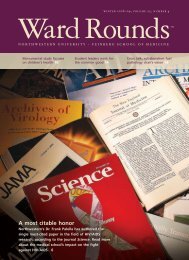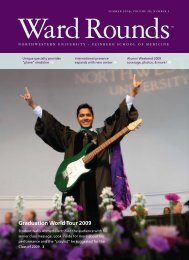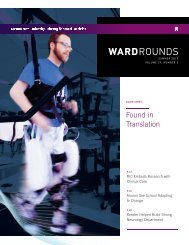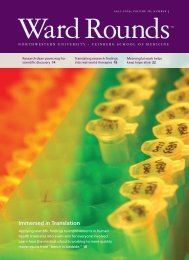Download PDF - Ward Rounds - Northwestern University
Download PDF - Ward Rounds - Northwestern University
Download PDF - Ward Rounds - Northwestern University
You also want an ePaper? Increase the reach of your titles
YUMPU automatically turns print PDFs into web optimized ePapers that Google loves.
DEAN’S MESSAGE WARD ROUNDS NEWS RESEARCH FEATURES ALUMNI NEWS PROGRESS NOTES UPCOMING EVENTS<br />
mortality rate<br />
of these youth<br />
more than<br />
quadruples that<br />
of the general<br />
population.<br />
In-house Data Collection<br />
In November 1995 the project kicked<br />
off with baseline interviews of detained<br />
youth between the ages of 10 and 18<br />
who would eventually form the original<br />
sample of 1,829. Three years later,<br />
<strong>Northwestern</strong> researchers launched<br />
the fi rst wave of follow-up interviews.<br />
Initially, the study addressed primarily<br />
psychiatric disorders. Over the course<br />
of the project, the focus has changed<br />
as participants have aged and face new<br />
threats to their health and well being.<br />
Including questions on HIV/AIDS risk<br />
behaviors as well as testing for HIV<br />
infection has added to the complexity of<br />
the data collection.<br />
Despite the labor-intensive and costly<br />
challenge of tracking the sample, the<br />
project has outstanding participation<br />
rates, thanks to the commitment of fi eld<br />
staff and participants. <strong>Northwestern</strong><br />
Project participants, like others involved<br />
in longitudinal studies, are compensated<br />
for their time. The project achieved a<br />
97.5 percent participation rate at its<br />
3-year follow-up and 87.7 percent for its<br />
11-year follow-up. The study is currently<br />
conducting 12-, 13- and 14-year followup<br />
interviews.<br />
“By the time we complete the next<br />
phase, we will have conducted more<br />
than 17,000 interviews, each of which<br />
includes more than 3,000 variables,”<br />
notes Leah J. Welty, PhD, assistant<br />
professor in preventive medicine and<br />
the project’s lead biostatistician. “The<br />
scope and size of the data allows us to<br />
use innovative statistical techniques to<br />
examine changes over time, both within<br />
individuals and in the population.”<br />
Unlike many large-scale<br />
epidemiologic studies that oſt en farm<br />
out data collection to survey research<br />
companies, the Feinberg School’s investigators<br />
chose to keep the function<br />
in-house. This has allowed the<br />
North western Project to achieve its<br />
exceptional participation rates as well<br />
as handpick and train interviewers<br />
to have greater sensitivity to human<br />
subjects’ issues.<br />
During the past 15 years, attrition<br />
of a violent nature has taken its toll on<br />
the sample now numbering 1,659. “Few<br />
participants withdraw from the study<br />
and relatively few are lost to follow-up,”<br />
remarks Dr. Teplin. “But 102 participants<br />
have died and most from homicide. This<br />
is a shockingly high number given the<br />
age of our participants.” Dr. Teplin and<br />
colleagues detailed this unusual fi nding<br />
in an article in the June 2005 issue of<br />
Pediatrics.<br />
From the beginning, the <strong>Northwestern</strong><br />
Project has examined health<br />
disparities in needs and outcomes in a<br />
population that is rarely investigated:<br />
delinquent youth. The research group’s<br />
fi ndings, from both the <strong>Northwestern</strong><br />
Project and prior studies, have shaped<br />
public health policy around the country.<br />
Results have been cited in Supreme<br />
Court amicus briefs, congressional<br />
hearings, and Surgeon General<br />
reports. In its next phase, the project<br />
will leverage longitudinal data already<br />
collected and add questions to address<br />
how disproportionate incarceration of<br />
minorities has aff ected their burden in<br />
the HIV/AIDS epidemic.<br />
“Many of these youth cycle in and out<br />
of detention centers, jails, and prisons.<br />
No one knows how incarceration aff ects<br />
their cognitive, emotional, and social<br />
development,” says co-investigator Jason<br />
J. Washburn, PhD, director of education<br />
and clinical training in the Division of<br />
Psychology. “Extending this study provides<br />
an unprecedented opportunity to examine<br />
how incarceration infl uences health<br />
trajectories from adolescence to young<br />
adulthood. Ultimately, we expect that<br />
these data will inform policies designed<br />
to address barriers to rehabilitation.”<br />
“<br />
Despite the labor-intensive<br />
and costly challenge of<br />
tracking the sample, the<br />
project has outstanding<br />
participation.<br />
“<br />
by the numbers<br />
1996<br />
year the study began<br />
10-18<br />
age range of interviewees<br />
at beginning of study<br />
1829<br />
number of the original<br />
group of detained youth<br />
1655<br />
number of participants<br />
¡∞ years later<br />
103<br />
number of participants<br />
who have died to date<br />
4x<br />
mortality rate of these youth<br />
compared to the general<br />
population<br />
$10.2<br />
amount of money the study<br />
recently received from nih<br />
Article Title:<br />
President’s<br />
Message<br />
The fall meeting of the medical school’s National Alumni Board<br />
proved to be the liveliest session I’ve had the privilege of attending<br />
during the several years I’ve been involved with the<br />
group. We began a little late as we cheered the Wildcats to a<br />
last-minute football victory over Minnesota. Then a presentation<br />
on the changes in the offi ces of Development, Alumni Relations,<br />
and the Dean generated thoughtful and creative ideas. Bruce<br />
Scharschmidt, president of the Nathan Smith Davis Club,<br />
described the response to a survey of the NAB that identifi ed<br />
opportunities for improved communication and engagement<br />
of <strong>Northwestern</strong> medical school alumni. Be prepared for more<br />
information about how you can stay connected. In addition to<br />
Alumni Weekend each spring, the following are just a few of the<br />
activities that enable alumni to stay engaged and give back:<br />
Medical school faculty host<br />
dinners (over 50) in their<br />
homes or restaurants of<br />
choice for incoming medical<br />
students during Orientation<br />
Week each year.<br />
Alumni awards include<br />
both NU (Merit) and FSM<br />
(Distinguished Alumnus<br />
Award, Dean’s Award,<br />
Service Award), as well as<br />
the Kenneth Viste Student<br />
Service Recognition<br />
Award to a graduating<br />
senior each year.<br />
Alumni serve as mentors for<br />
fi rst- and second-year students<br />
at luncheon roundtables<br />
during Alumni Weekend,<br />
encouraging students in their<br />
choice of future specialty.<br />
Alumni volunteers all over<br />
the country host fourth-year<br />
medical students traveling<br />
to their areas for residency<br />
interviews.<br />
Alumni contributions to all<br />
medical school funds average<br />
over $2 million annually.<br />
We encourage you to share other ideas to help keep you in touch<br />
with <strong>Northwestern</strong>. Contact me at dcarr@billingsclinic.org or<br />
Ginny Darakjian at v-darakjian@northwestern.edu.<br />
All the best!<br />
F. Douglas Carr, MD ’78, MMM<br />
President, Alumni Association<br />
Article Title:<br />
<strong>Ward</strong> <strong>Rounds</strong> Survey –<br />
Alums Want More Progress Notes!<br />
In the summer 2010 issue of <strong>Ward</strong> <strong>Rounds</strong>, readers were asked to<br />
share feedback about the magazine’s content. We also wanted<br />
to know if alumni would access the online-only issues two<br />
times a year and what new elements should be included with<br />
the Web version.<br />
We thank those individuals who took the time to respond. While<br />
overall most are very satisfi ed with the content and quality of the<br />
magazine, there are areas for improvement. We were heartened<br />
to learn that a majority of the respondents would access the online<br />
version of the magazine when a hard copy is unavailable.<br />
With the redesign of the magazine, the timing was optimal to<br />
begin implementing reader suggestions. We encourage you to<br />
continue to tell us how we are doing.<br />
Top 3 Sections Readers Value<br />
1 Progress Notes – Alumni want more news from fellow medical<br />
school graduates. We will devote more space to updates from<br />
alumni and will send more reminders to encourage participation.<br />
2 Alumni News – Readers want to see more alumni profi les. We<br />
will include more variety in our profi les (feature younger graduates<br />
and current residents) and will experiment with shorter pieces.<br />
3 Feature articles – Alumni want more information about medical<br />
students, updates from the dean, and news about community<br />
service and patient-care programs. We will cover more content in<br />
these areas.<br />
Online Access<br />
While some of our respondents fi nd reading longer pieces on a<br />
computer screen diffi cult and less enjoyable, 70 percent said they<br />
would go online to get updates about the medical school when<br />
a print copy of <strong>Ward</strong> <strong>Rounds</strong> is unavailable. When asked what<br />
elements would improve their online experience, here’s what<br />
alumni told us…<br />
video<br />
blog posting<br />
audio<br />
If you would like to learn more about the <strong>Ward</strong> <strong>Rounds</strong> redesign<br />
and how it will improve the reader experience, see “<strong>Ward</strong> <strong>Rounds</strong><br />
Sports New Design” on page 3.<br />
55<br />
25<br />
15<br />
p.22 — wardroundsonline.com<br />
ward rounds winter 2010-11 — p.23












